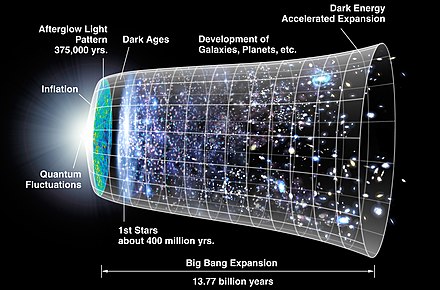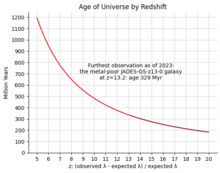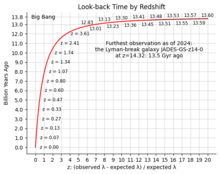
A | B | C | D | E | F | G | H | CH | I | J | K | L | M | N | O | P | Q | R | S | T | U | V | W | X | Y | Z | 0 | 1 | 2 | 3 | 4 | 5 | 6 | 7 | 8 | 9
This article needs additional citations for verification. (November 2023) |
| Part of a series on |
| Physical cosmology |
|---|
The chronology of the universe describes the history and future of the universe according to Big Bang cosmology.
Research published in 2015 estimates the earliest stages of the universe's existence as taking place 13.8 billion years ago, with an uncertainty of around 21 million years at the 68% confidence level.[1]
−13 — – −12 — – −11 — – −10 — – −9 — – −8 — – −7 — – −6 — – −5 — – −4 — – −3 — – −2 — – −1 — – 0 — |
| |||||||||||||||||||||||||||||||||||||||
Outline
Chronology in five stages

For the purposes of this summary, it is convenient to divide the chronology of the universe since it originated, into five parts. It is generally considered meaningless or unclear whether time existed before this chronology:
The very early universe
The first picosecond (10−12) of cosmic time includes the Planck epoch, during which currently established laws of physics may not have applied; the emergence in stages of the four known fundamental interactions or forces—first gravitation, and later the electromagnetic, weak and strong interactions; and the accelerated expansion of the universe due to cosmic inflation.
Tiny ripples in the universe at this stage are believed to be the basis of large-scale structures that formed much later. Different stages of the very early universe are understood to different extents. The earlier parts are beyond the grasp of practical experiments in particle physics but can be explored through the extrapolation of known physical laws to extreme high temperatures.
The early universe
This period lasted around 370,000 years. Initially, various kinds of subatomic particles are formed in stages. These particles include almost equal amounts of matter and antimatter, so most of it quickly annihilates, leaving a small excess of matter in the universe.
At about one second, neutrinos decouple; these neutrinos form the cosmic neutrino background (CνB). If primordial black holes exist, they are also formed at about one second of cosmic time. Composite subatomic particles emerge—including protons and neutrons—and from about 2 minutes, conditions are suitable for nucleosynthesis: around 25% of the protons and all the neutrons fuse into heavier elements, initially deuterium which itself quickly fuses into mainly helium-4.
By 20 minutes, the universe is no longer hot enough for nuclear fusion, but far too hot for neutral atoms to exist or photons to travel far. It is therefore an opaque plasma.
The recombination epoch begins at around 18,000 years, as electrons are combining with helium nuclei to form He+
. At around 47,000 years,[2] as the universe cools, its behavior begins to be dominated by matter rather than radiation. At around 100,000 years, after the neutral helium atoms form, helium hydride is the first molecule. Much later, hydrogen and helium hydride react to form molecular hydrogen (H2) the fuel needed for the first stars. At about 370,000 years,[3][4][5][6] neutral hydrogen atoms finish forming ("recombination"), and as a result the universe also became transparent for the first time. The newly formed atoms—mainly hydrogen and helium with traces of lithium—quickly reach their lowest energy state (ground state) by releasing photons ("photon decoupling"), and these photons can still be detected today as the cosmic microwave background (CMB). This is the oldest direct observation we currently have of the universe.
The Dark Ages and large-scale structure emergence

This period measures from 370,000 years until about 1 billion years. After recombination and decoupling, the universe was transparent but the clouds of hydrogen only collapsed very slowly to form stars and galaxies, so there were no new sources of light. The only photons (electromagnetic radiation, or "light") in the universe were those released during decoupling (visible today as the cosmic microwave background) and 21 cm radio emissions occasionally emitted by hydrogen atoms. The decoupled photons would have filled the universe with a brilliant pale orange glow at first, gradually redshifting to non-visible wavelengths after about 3 million years, leaving it without visible light. This period is known as the cosmic Dark Ages.
At some point around 200 to 500 million years, the earliest generations of stars and galaxies form (exact timings are still being researched), and early large structures gradually emerge, drawn to the foam-like dark matter filaments which have already begun to draw together throughout the universe. The earliest generations of stars have not yet been observed astronomically. They may have been huge (100–300 solar masses) and non-metallic, with very short lifetimes compared to most stars we see today, so they commonly finish burning their hydrogen fuel and explode as highly energetic pair-instability supernovae after mere millions of years.[8] Other theories suggest that they may have included small stars, some perhaps still burning today. In either case, these early generations of supernovae created most of the everyday elements we see around us today, and seeded the universe with them.

Galaxy clusters and superclusters emerge over time. At some point, high-energy photons from the earliest stars, dwarf galaxies and perhaps quasars leads to a period of reionization that commences gradually between about 250–500 million years and finishes by about 1 billion years (exact timings still being researched). The Dark Ages only fully came to an end at about 1 billion years as the universe gradually transitioned into the universe we see around us today, but denser, hotter, more intense in star formation, and more rich in smaller (particularly unbarred) spiral and irregular galaxies, as opposed to giant elliptical galaxies.
While early stars have not been observed, galaxies have been observed from 329 million years since the Big Bang, with JADES-GS-z13-0 which the James Webb Space Telescope observed with a redshift of z=13.2, from 13.4 billion years ago.[9][10] The JWST was designed to observe as far as z≈20 (180 million years cosmic time).[citation needed]
To derive the age of the universe from redshift, numeric integration or its closed-form solution involving the special Gaussian hypergeometric function 2F1 may be used:[7]
Lookback time is the age of the observation subtracted from the present age of the universe:
The universe as it appears today
From 1 billion years, and for about 12.8 billion years, the universe has looked much as it does today and it will continue to appear very similar for many billions of years into the future. The thin disk of our galaxy began to form at about 5 billion years (8.8 Gya),[11] and the Solar System formed at about 9.2 billion years (4.6 Gya), with the earliest traces of life on Earth emerging by about 10.3 billion years (3.5 Gya).
The thinning of matter over time reduces the ability of gravity to decelerate the expansion of the universe; in contrast, dark energy (believed to be a constant scalar field throughout the visible universe) is a constant factor tending to accelerate the expansion of the universe. The universe's expansion passed an inflection point about five or six billion years ago, when the universe entered the modern "dark-energy-dominated era" where the universe's expansion is now accelerating rather than decelerating. The present-day universe is understood quite well, but beyond about 100 billion years of cosmic time (about 86 billion years in the future), uncertainties in current knowledge mean that we are less sure which path the universe will take.[12][13]
The far future and ultimate fate
At some time the Stelliferous Era will end as stars are no longer being born, and the expansion of the universe will mean that the observable universe becomes limited to local galaxies. There are various scenarios for the far future and ultimate fate of the universe. More exact knowledge of the present day universe may allow these to be better understood.
Tabular summary
- Note: The radiation temperature in the table below refers to the cosmic background radiation and is given by 2.725 K·(1 + z), where z is the redshift.
| Epoch | Time | Redshift | Radiation temperature (Energy) [verification needed] |
Description |
|---|---|---|---|---|
| Planck epoch |
< 10−43 s | > 1032 K ( > 1019 GeV) |
The Planck scale is the physical scale beyond which current physical theories may not apply and cannot be used to reliably predict any events. During the Planck epoch, cosmology and physics are assumed to have been dominated by the quantum effects of gravity. | |
| Grand unification epoch |
< 10−36 s | > 1029 K ( > 1016 GeV) |
The three forces of the Standard Model are still unified (assuming that nature is described by a Grand Unified Theory, gravity not included). | |
| Inflationary epoch Electroweak epoch |
< 10−32 s | 1028 K ~ 1022 K (1015 ~ 109 GeV) |
Cosmic inflation expands space by a factor of the order of 1026 over a time of the order of 10−36 to 10−32 seconds. The universe is supercooled from about 1027 down to 1022 Kelvins.[14] The strong interaction becomes distinct from the electroweak interaction. | |
| Electroweak epoch ends |
10−12 s | 1015 K (150 GeV) |
Before temperature falls below 150 GeV, the average energy of particle interactions is high enough that it's more succinct to describe them as an exchange of W1, W2, W3, and B vector bosons (electroweak interactions) and H+, H−, H0, H0⁎ scalar bosons (Higgs interaction). In this picture, the vacuum expectation value of the Higgs field is zero (therefore, all fermions are massless), all electroweak bosons are massless (they had not yet subsumed a component of the Higgs field to become massive), and photons (γ) do not yet exist (they will exist after a phase transition as a linear combination of B and W3 bosons, γ = B cos θW + W3 sin θW, where θW is the Weinberg angle). These are the highest energies directly observable in the Large Hadron Collider. The sphere of space that will become the observable universe is approximately 300 light-seconds (~0.6 AU) in radius at this time. | |
| Quark epoch | 10−12 s ~ 10−5 s | Zdroj:https://en.wikipedia.org?pojem=Chronology_of_the_universe



